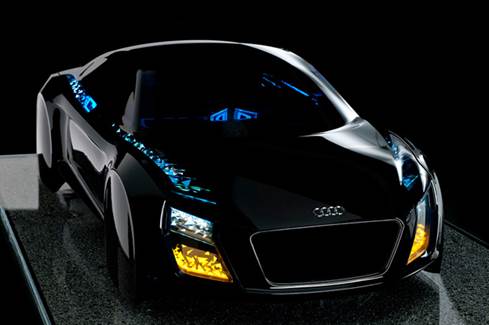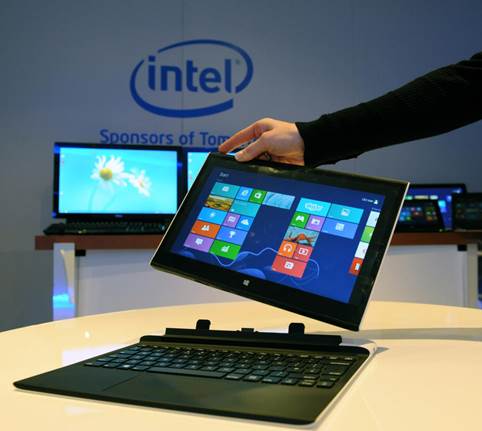Cometh forth 4K
4K madness has also stormed the television
department. And...wait for it...there is an 8K (7680 x 4320 resolutions) TV
too! It just so happen that Sharp decided to step in during all the 4K TV
introduction to show off its 8K TV. This 85in is still in the prototype stage
and even if the company releases it to the public, there is still no
commercialized 8K content. Remember, this is just the beginning of 4K stuff.
Don't worry, Sharp has also unveiled its first 32in 4K TV together with other
premium 4K TVs.

Other
brands like Toshiba, Sony, Samsung, Panasonic and Vizio came out with 4K TVs
with sizes ranging from 55in to 90in
Aside from that, other brands like Toshiba,
Sony, Samsung, Panasonic and Vizio came out with 4K TVs with sizes ranging from
55in to 90in. This means users can look forward to more 4K content as these higher
resolutions televisions slowly gain its traction. As of now, users will just
have to settle with an upscale version of 1080p movies.
Additionally, those who are looking for PC
monitors that go beyond 27in need not look further. ViewSonic and LG have debut
their 32in monitors at CES, and – get this – they are 4K monitors. The asking
price for the 4K monitor is on the higher end spectrum, between US$10,000 and
US$20,000. Fret not as there is also a manufacturer brand that goes by the name
of Monoprice dragging the price down for mainstream usage.
There is one other buzzword going around
the CES floor as well: Organic LED TVs (aka OLED TVs). If 4K is the kick-off
for TVs in 2013, OLED will be the ‘big deal’ for this year. All major brands –
from Sony to LG and even Samsung as well as Sharp - have set up large booths to
introduce and showcase these long a waited TV tech. There is more reason to be
excited about TVs now!
Smarter cars
Technologies on the go are already here but
how about technologies on the road? To answer that, CES, and Las Vegas by
proxy, showcased quite a number of interesting auto gadgets this year. The
biggest highlight: self-driving features. The major highlight is Audi's
self-parking car, which had a piloted-driving demo showing off what it could
do. Not only will it help out those who still can't get the right parking
technique down to pat, it also will support with navigating through rush hour.
Don't expect high speed self-driving though as this goes more towards remedying
driver error than a super AI driving your car.

The
major highlight is Audi's self-parking car, which had a piloted-driving demo
showing off what it could do
Moving to the in-car experience, Ford and
GM teamed up to invite more developers to participate in their SYNC AppLink and
MyLink SDK programs. Think apps and infotainment merged into one platform.
These will most probably touch about traffic conditions, voice activation and
more.
There is also the Bentley Continental GT.
Indeed, a beautiful car with price-tag to match. So, how does one further
increase its value technologically? Why, by allowing QNX to rip out all of the
dash-mounted electronics and install three screens, video conferencing, ultra
HD sound and a 3D back-up camera. That's how a supercar and high-end car
manufacturer show off its Car Platform 2.0 in style.
Touchy-feel
This year, the revolution of touchscreen
notebooks and ultrabooks continue. However, the one that caught our attention
is Intel’s North Cape Hybrid. What's so special about it? Why, inside there is
Intel's next-generation Haswell platform. It is coming out in a few months, so,
why not see it now? At 13.3in and using a 1080p display, it also sports two USB
3.0 ports, micro HDMI connector, the ever important power jack and a 3.5mm
audio port around the chassis. Pretty unfortunate that no other specs had been
revealed, so we have to sit back and wait for it like everyone else.

At
13.3in and using a 1080p display, Intel’s North Cape Hybrid also sports two USB
3.0 ports, micro HDMI connector, the ever important power jack and a 3.5mm
audio port around the chassis
Aside from that, other interesting
notebooks/Ultrabooks include the Lenovo Helix with its ability to dock the
tablet towards the keyboard or putting it on backwards. It even has the ability
to overclock itself after docking on the keyboard, with the right settings of
course. There is also the powerful Samsung Series 7 Chronos, which uses a
2.4GHz Intel Core i7 3635QM CPU and a Radeon HD 8870M.
Let's not forget MSI's Windows 8 tablet.
It’s called the MSI Slidebook S20 and...wait a minute... it is a notebook too.
The display slides upward to reveal the tablet’s native keyboard. Speaking of
sliding mechanisms that show off the keyboard, LG also has a slider device that
goes by the name of Tab-Book H160. Interestingly, the Atom CPU powered
notebook's display will slide up with just a press of a button.
A new look for gaming
It seems that gaming is going through a
change as well. NVIDIA's Project Shield is definitely one fine example of the
coming trend. Before you ask, no, it is not a smartphone glued to a game
controller. This will be NVIDIA's first standalone game console hardware and it
has the company's new GRID server architecture for managing cloud game
streaming. Think about it: Tegra 4 chip, GTX 680 graphics card and Steam
launched directly from Tegrazone. Gamers will flood the room with drools.
Gamers can keep on smiling because Valve's
Steam Box project is also out of the box (but is not yet for sale). It is
Valve's effort to introduce a living-room friendly PC made to run its Steam
gaming client in Big Picture Mode. Next is a Kickstarter breakout called Oculus
Rift. This virtual reality headset project has a pair of 640 x 800 displays -
one for each eye and motion tracking. Just imagine: 360 degrees of viewing
angle. That's true immersive gaming right there.